Barracudas, swordfish, and marlins were included in the Scombroidei suborder of the Perciformes order not so long ago. Recently, they have been included in the separate Istiophoriformes order.

(“Old Man and the Sea”. Painting by Carey Chen, 2011. careychen.com)
The barracudas (Sphyraenidae) family comprises 28 fish species of the monotypic barracudas or cudas (Sphyraena) genus. Their distinctive features are as follows: a long, elongated body and an underhung lower jaw, which is armed with teeth resembling canines in some species.
Barracudas are inhabitants of subtropical and tropical waters of the World Ocean, predators that feed on fish, squid, and large shrimps. Adult specimens are often solitary predators; smaller fish hunt in schools. The largest representatives of the family are as follows: Guinean barracuda (Sphyraena afra), which inhabits the eastern part of the Atlantic Ocean along the African coast from Mauritania to Namibia, may weigh up to 50 kilograms and maybe more than two meters long; and great barracuda (Sphyraena barracuda), which is found in the subtropical waters of the Indian, Pacific, and Atlantic oceans and is of the same size. A record great barracuda specimen, caught with a spinning tackle, weighed 46.7 kilograms.
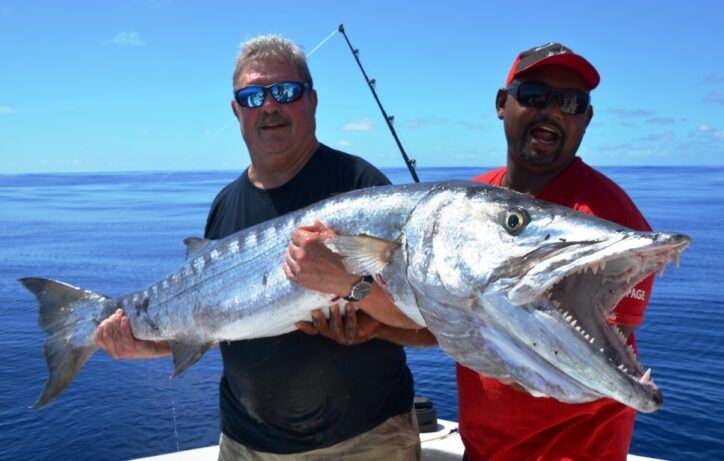
(Great barracuda. Photo © rodfishingclub.com)
In 2005, 2009, and 2015, three species of the family previously unknown to science were described for the first time, which again shows us how many new acquaintances with the inhabitants of the seas and oceans we have ahead.
If people eat the flesh of barracuda, inhabiting tropical waters, they may be unpleasantly surprised because it may cause poisoning with a biological poison contained in the tissues of some reef fishes – ciguatoxin, which causes a disease called ciguatera. adriaticnature dealt with this ailment in the article “Dangerous Inhabitants of the Adriatic Sea. Fish”. In short – one shouldn’t be afraid of ciguatera when eating the flesh of Adriatic barracuda. The following three species of the family are found in the Adriatic Sea.
Yellowstripe barracuda (Sphyraena chrysotaenia).

(Yellowstripe barracuda. Photo © renotonna.yolasite.com)
It’s a pelagic coastal species. The maximum recorded length is 30 cm. It feeds on fish, less often on cephalopods and crustaceans. It’s a rare species found in the Mediterranean Sea that entered it through the Suez Canal. It was found several times in the southern part of the Adriatic Sea.
European barracuda (Sphyraena sphyraena).

(European barracuda. Photo © adriaticnature.com)
It’s a pelagic coastal species. It inhabits the depths of up to 100 meters, usually up to 50 meters. The maximum recorded length is 165 cm; specimens up to 60 cm long are more common. The maximum weight is 3.6 kilograms. It feeds on fish, less often on cephalopods and crustaceans. It’s a permanent inhabitant of the Adriatic Sea.
Yellowmouth barracuda (Sphyraena viridensis).
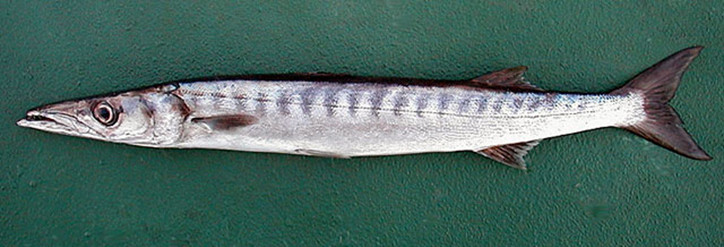
(Yellowmouth barracuda. Photo by © Pedro Niny Duarte(c)ImagDOP. fishbase.org)
The maximum recorded length is 128 cm; specimens up to 50 cm long are more common. The maximum weight is 8.2 kilograms, according to unconfirmed data – 12 kilograms. It feeds on fish, cephalopods, and crustaceans. It’s a permanent inhabitant of the Adriatic Sea, which is more rarely found in its northern part.
The Istiophoridae family comprises 11 fish species of 5 genera. And although only one representative of the family is found in the Adriatic, there’s no way we miss the chance to talk about these powerful and beautiful fish, especially in relation to anglers traveling on other seas.
Istiophoridae is among the fastest marine fishes. Atlantic blue marlin (Makaira nigricans), the largest representative of the family, maybe up to 5 meters long and weigh 818 kilograms. These fishes are among the most popular sea sport fishing targets.
The Istiophorus genus comprises two fish species:
Atlantic sailfish (Istiophorus albicans) is an inhabitant of the tropical and temperate waters of the Atlantic Ocean. It’s a pelagic oceanic schooling predator that may be up to 315 centimeters long and weigh 58.1 kilograms. It feeds mainly on small pelagic fish. Small specimens enter the Mediterranean Sea while migrating, but they don’t make it to the Adriatic. It’s a popular sport fishing target.

(Atlantic sailfish. Photo by © ryans sail 014. wikipedia.org)
Indo-Pacific sailfish (Istiophorus platypterus) is an inhabitant of the tropical and temperate waters of the Pacific and the Indian oceans. It’s a pelagic schooling predator, feeding mainly on fish, crustaceans, and cephalopods. It may be up to 348 centimeters long and weigh up to 100 kilograms. After the Suez Canal had been built, it began to migrate from the Red Sea to the Mediterranean Sea, but it hasn’t been found in the Adriatic yet.

(Indo-Pacific sailfish. Photo © oceanbluefishing.com)
The Makaira genus comprises two fish species:
Indo-Pacific blue marlin (Makaira mazara) is an inhabitant of the tropical and subtropical waters of the Pacific and the Indian Ocean. It’s a pelagic schooling predator, feeding mainly on fish, squid, and crustaceans. Large specimens are more often solitary. They may be up to 5 meters long and weigh 170 kilograms. It’s a popular sport fishing target.
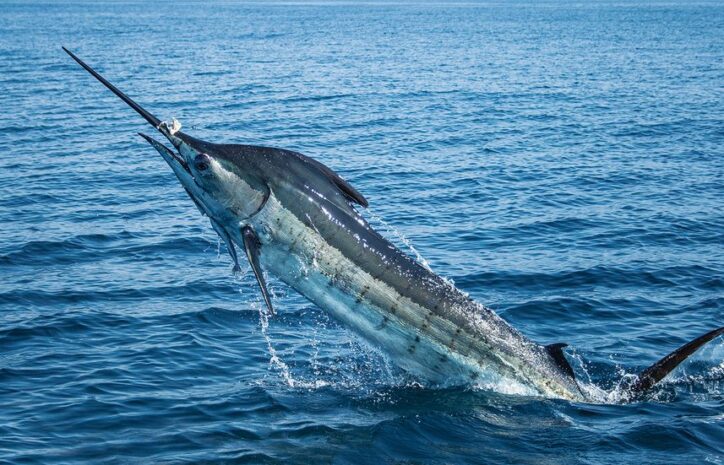
(Indo-Pacific blue marlin. Photo by © Henry Badenhorst. marlinmag.com)
Makaira nigricans is the largest fish of the family, known to most people from the short novel “The Old Man and the Sea” by Ernest Hemingway, in which a fisherman named Santiago tried to play a blue marlin for three days. It inhabits the tropical and temperate waters of the Atlantic Ocean, mainly in its western part, and doesn’t enter the Mediterranean Sea. It’s a pelagic predator that feeds mainly on fish. It may be up to 5 meters long and weigh 818 kilograms, but the officially registered maximum weight is 636 kilograms. It’s one of the most popular Big Game Fishing trophies in the world.
The Kajikia genus comprises two fish species:
Atlantic white marlin (Kajikia albida) is an inhabitant of the tropical and subtropical waters of the Atlantic Ocean. Occasionally it enters the Mediterranean Sea but doesn’t make it to the Adriatic. It feeds mainly on flying fish, mahi-mahi, medium-sized tuna, and squid. It may be up to 300 centimeters long and weigh 82.5 kilograms.
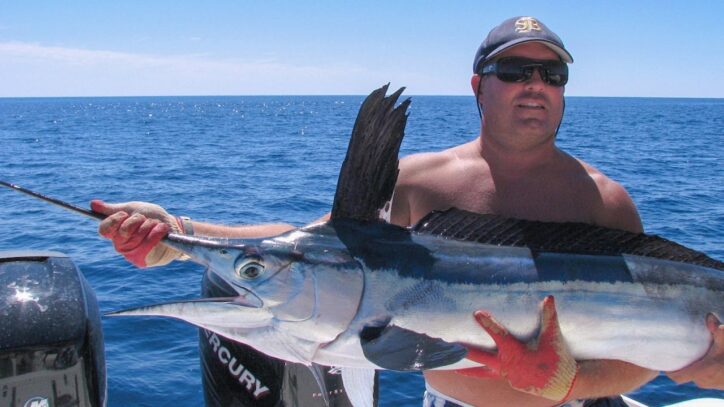
(Atlantic white marlin. Photo © YouTubeFISHINGVIDS)
Striped marlin (Kajikia audax) is an inhabitant of the Indo-Pacific region of the World Ocean. It may be up to 420 centimeters long and weigh 440 kilograms. It’s a pelagic predator that inhabits the depths of up to 200 meters. It feeds on fish, crustaceans, and squid.
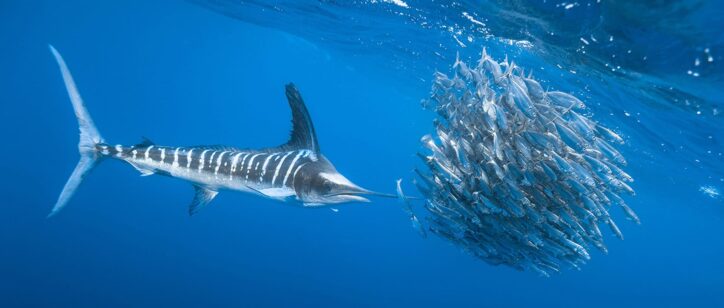
(Striped marlin. Photo by © Martin Hristov. biganimals.com)
The Istiompax genus is represented by one species – black marlin (Istiompax indica). It’s an inhabitant of the coastal waters of the Indian Ocean and the Pacific Ocean, which may be up to 465 centimeters long and weigh 750 kilograms. It feeds on fish, squid, cuttlefish, octopuses. It’s a popular sport fishing target.
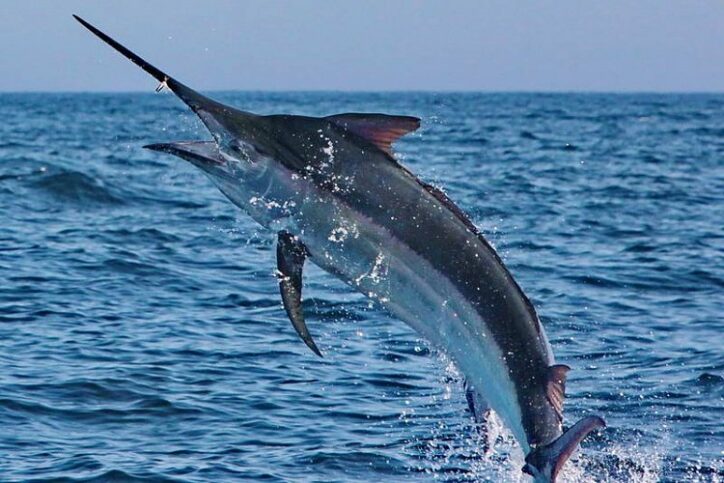
(Black marlin. Photo by © Nick Froelich. grayfishtagresearch.org)
The Tetrapturus genus comprises four fish species, one of which is found in the Adriatic Sea:
Shortbill spearfish (Tetrapturus angustirostris) is widespread in the Indo-Pacific region, it may be up to 230 centimeters long and weigh 52 kilograms. It’s a pelagic species.
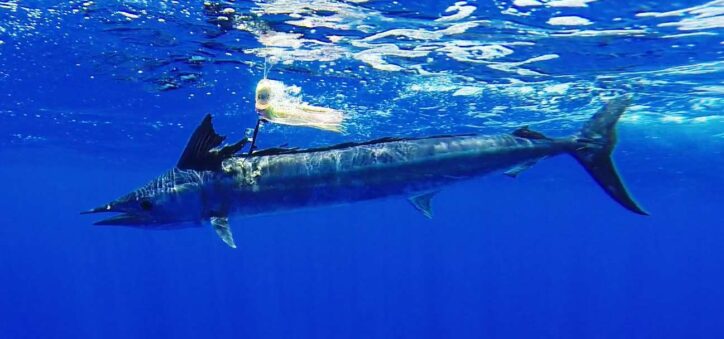
(Shortbill spearfish. Photo © rodfishingclub.com)
Longbill spearfish (Tetrapturus pfluegeri) is a widespread species in the coastal waters of the Atlantic Ocean, which is more often found in its western part. It may be up to 254 centimeters long and weigh 58 kilograms.
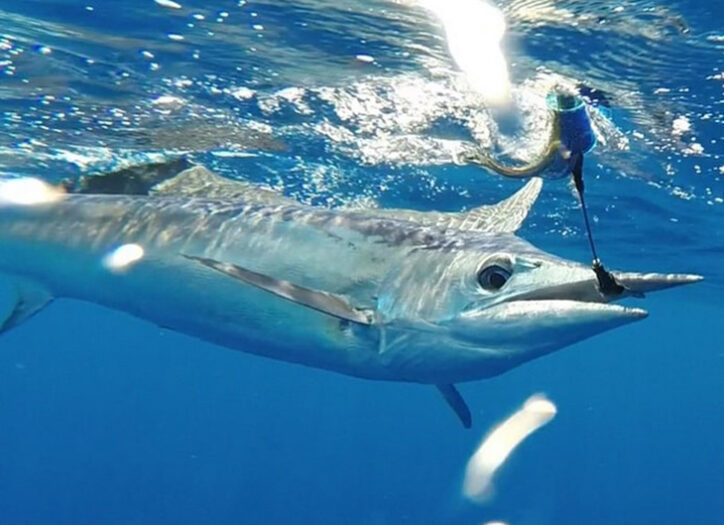
(Longbill spearfish. Photo © fishidentificationblog.blogspot.com)
Roundscale spearfish (Tetrapturus georgii) is an inhabitant of the eastern Atlantic and the Mediterranean Sea, known from the waters around Sicily, the Strait of Gibraltar, and the Atlantic Ocean off the southern coast of Portugal. It’s an understudied species. The maximum recorded length is 184 centimeters, weight – 21.5 kilograms.
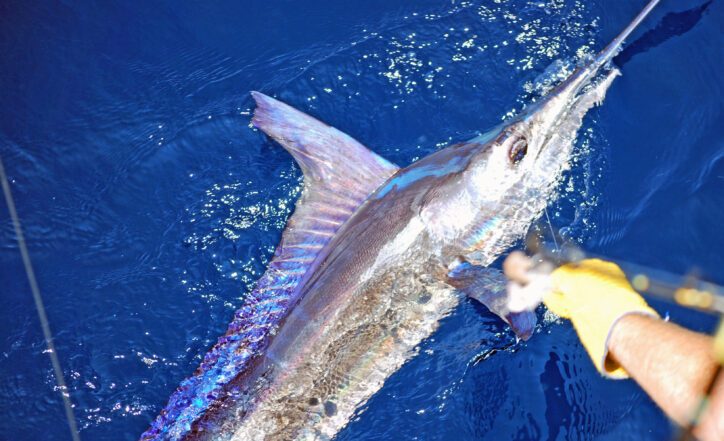
(Roundscale spearfish. Photo by © Ken Neill. healthygrinsportfishing.com)
Mediterranean spearfish (Tetrapturus belone).

(Mediterranean spearfish. Photo by © Thibault Dominguez. fishfriender.com)
Mediterranean spearfish is endemic to the Mediterranean Sea. It is most often seen off the coast of Italy. It prefers to swim in a 200-meter layer of water, usually above or within the thermocline. It travels in pairs. It feeds on fish. It may be up to 240 centimeters long and weigh 70 kilograms. It’s an understudied species. It’s an inhabitant of the Adriatic Sea.
The only representative of the Xiphiidae family – swordfish (Xiphias gladius), is a permanent inhabitant of the Adriatic Sea and a sport fishing target. It is widespread in the Pacific, Atlantic, and Indian oceans. It may be up to 455 centimeters long and weigh 650 kilograms. It usually prefers to swim at depths of up to 550 meters. It feeds mainly on pelagic fish, squid, and crustaceans. It is included in the IUCN Red List as an Endangered Species (EN).

(Swordfish. Photo by © Pierre Jaquet. flickr.com/photos/pierre_et_nelly)